Recovery of Rare Earth Elements from Waste Phosphate-Based Phosphors Containing Glass by Pre-Enrichment—Alkali Roasting Method
Abstract
1. Introduction
2. Materials and Methods
2.1. Materials
2.2. Experimental Methods
- (1)
- Pre-enrichment—Sieving and Desiliconization:
- (2)
- Pre-enrichment—Acid Leaching for Calcium Removal:
- (3)
- Alkaline Roasting:
- (4)
- Leaching of Rare Earth Elements:
- (5)
- Precipitation of Rare Earth Elements:
3. Results and Discussion
3.1. Pre-Enrichment—Sieving Desiliconization
3.2. Pre-Enrichment—Pickling for Calcium Decrease
3.3. Alkaline Roasting
3.3.1. TG-DSC Analysis of Baking Process of Sodium Carbonate
- (1)
- The first endothermic peak, observed below 100 °C and accompanied by a mass loss of approximately 2.6%, is attributed to the evaporation of free water absorbed by the raw material. Similar endothermic DSC peaks resulting from moisture evaporation have been frequently reported in various thermal processes, including alkaline hydrolysis and thermal decomposition [32,33].
- (2)
- The second endothermic peak, occurring between 100 and 200 °C, corresponds to a heat-absorbing process. It should be noted that the TG-DSC sample was limited in mass (10 mg) and consisted of fine powder (1–5 μm). The large specific surface area of the sample facilitated contact with air during preparation, promoting the absorption of moisture and the reaction of Na2CO3 with atmospheric CO2 to form NaHCO3. The latter compound is thermally unstable and undergoes endothermic decomposition upon heating, significantly influencing the DSC curve. The principal reaction in this temperature range is reaction 3. Due to the small sample mass and the excess of Na2CO3 present, the thermal behavior observed between 100 and 200 °C is primarily manifested as the second endothermic peak in Figure 6.
- (3)
- As the temperature further increased to 712 °C, a pronounced exothermic peak emerged, accompanied by a significant mass loss of 9.73 wt%. This indicates the occurrence of a reaction between the waste phosphor and sodium carbonate. Accordingly, the decomposition temperature of the waste phosphor in the alkaline medium is determined to be within the range of 620–867 °C.
3.3.2. Influence of Alkaline Roasting on the Surface Morphology of Waste Phosphors
3.3.3. Phase Change in Waste Phosphor During Baking Process of Sodium Carbonate
3.3.4. The Crystal Structure Cracking Process of Waste Phosphor in Alkali Roasting
3.4. Hydrochloric Acid Leaching
3.5. Ammonium Sulphate-Oxalic Acid Combined Separation of Rare Earth and Calcium in Solution
4. Conclusions
- (1)
- Pre-enrichment—screening and desilication: After screening with a 30-micron sieve, approximately 17.9% of the glass fragments were removed. At the same time, the grade of the waste phosphor (REO) increased from 9.3% to 10.9%.
- (2)
- Pre-enrichment—pickling for calcium decrease: low concentration citric acid/HCl mixed acid washing waste phosphor, REO increased from 10.9% before pickling to 17.0% and Ca and P decreased from 24.8% and 11.9% before pickling to 13.0%, 6.4%.
- (3)
- The results of the alkali roasting mechanism showed that REPO4 was converted into Na3PO4 and REO by alkaline roasting; the morphology, particle size, and phase of waste phosphor changed obviously before and after alkali roasting, and the internal structure of the crystal was effectively destroyed, and the leaching performance was obviously improved.
- (4)
- Adding excess ammonium sulfate before the precipitation of the rare earth with oxalic acid can achieve the separation of the rare earth and calcium. The precipitation rate of rare earth is 99.4% and the removal rate of calcium is 99.6%.
- (5)
- This process can improve the recovery efficiency of rare earth elements while reducing material consumption, ultimately yielding a rare earth oxalate precipitate with a grade (REO) of 49.0% and a total rare earth recovery rate of 96.6%.
Author Contributions
Funding
Data Availability Statement
Conflicts of Interest
References
- Xu, S.; Liu, C.; Sun, Z.; Li, Y.; Jie, Y.; Wang, X. Research progress on recovery methods of rare earth elements from waste fluorescent lamps. Rare Met. 2021, 45. [Google Scholar] [CrossRef]
- Li, J.; Diamond, D.B.; Bauer, D.J. U.S. Department of Energy Critical Materials Strategy; Office of Scientific & Technical Information Technical Reports: Oak Ridge, TN, USA, 2010. [Google Scholar] [CrossRef]
- Swain, N.; Mishra, S. A review on the recovery and separation of rare earths and transition metals from secondary resources. J. Clean. Prod. 2019, 220, 884. [Google Scholar] [CrossRef]
- Patil, A.B.; Viktoria, P.; Struis Rudolf, P.W.J.; Ludwig, C. Separation and Recycling Potential of Rare Earth Elements from Energy Systems: Feed and Economic Viability Review. Chromatography 2022, 9, 56. [Google Scholar] [CrossRef]
- Stojković, M.; Ristić, M.; Đolić, M.; Perić Grujić, A.; Onjia, A. Recovery of Rare Earth Elements from Coal Fly and Bottom Ashes by Ultrasonic Roasting Followed by Microwave Leaching. Metals 2024, 14, 17. [Google Scholar] [CrossRef]
- Slavković-Beškoski, L.; Ignjatović, L.; Ćujić, M.; Vesković, J.; Trivunac, K.; Stojaković, J.; Perić-Grujić, A.; Onjia, A. Ecological and Health Risks Attributed to Rare Earth Elements in Coal Fly Ash. Toxics 2024, 12, 71. [Google Scholar] [CrossRef]
- Binnemans, K.; Jones, P.T. Perspectives for the recovery of rare earths from end-of-life fluorescent lamps. J. Rare Earths 2014, 32, 195. [Google Scholar] [CrossRef]
- Binnemans, K.; Jones, P.T.; Blanpain, B.; Van Gerven, T.; Yang, Y.; Walton, A.; Buchert, M. Recycling of Rare Earths: A Critical Review. J. Clean. Prod. 2013, 51, 1–22. [Google Scholar] [CrossRef]
- Ippolito, N.M.; Belardi, G.; Piga, L. Determination of mineralogical composition of spent fluorescent powders by coupling ICP-spectroscopy and electronic microprobe analyses. TrAC Trends Anal. Chem. 2017, 94, 14–20. [Google Scholar] [CrossRef]
- Zhou, B. Research Progress on the Extraction and Separation of Rare-Earth Elements from Waste Phosphors. Minerals 2025, 15, 61. [Google Scholar] [CrossRef]
- Tanaka, M.; Oki, T.; Koyama, K.; Narita, H.; Oishi, T. Chapter 255—Recycling of Rare Earths from Scrap. Handb. Phys. Chem. Rare Earths 2013, 43, 159–211. [Google Scholar] [CrossRef]
- Tunsu, C.; Petranikova, M.; Gergorić, M.; Ekberg, C.; Retegan, T. Reclaiming Rare Earth Elements from End-of-Life Products: A Review of the Perspectives for Urban Mining Using Hydrometallurgical Unit Operations. Hydrometallurgy 2015, 156, 239–258. [Google Scholar] [CrossRef]
- Wu, Y.; Yin, X.; Zhang, Q.; Wang, W.; Mu, X. The Recycling of Rare Earths from Waste Tricolor Phosphors in Fluorescent Lamps: A Review of Processes and Technologies. Resour. Conserv. Recycl. 2014, 88, 21–31. [Google Scholar] [CrossRef]
- Tan, Q.; Li, J.; Zeng, X. Rare Earth Elements Recovery from Waste Fluorescent Lamps: A Review. Crit. Rev. Environ. Sci. Technol. 2015, 45, 749–776. [Google Scholar] [CrossRef]
- Yang, F.; Kubota, F.; Baba, Y.; Kamiya, N.; Goto, M. Selective Extraction and Recovery of Rare Earth Metals from Phosphor Powders in Waste Fluorescent Lamps Using an Ionic Liquid System. J. Hazard. Mater. 2013, 254–255, 79–88. [Google Scholar] [CrossRef]
- Mei, G.; Rao, P.; Matsuda, M.; Fujita, T. Separation of Red (Y2O3:Eu3+), Blue (BaMgAl10O17:Eu2+) and Green (CeMgAl10O17:Tb3+) Rare Earth Phosphors by Liquid/Liquid Extraction. J. Wuhan Univ. Technol. Mater. Sci. Ed. 2009, 24, 603–607. [Google Scholar] [CrossRef]
- Mei, G.; Xie, K. Recovery of Red (Y2O3:Eu3+), Blue(Sr,Ca,Ba)10(PO4)6Cl2:Eu2+ and Green(LaPO4:Tb3+,Ce3+) Rare Earth Phosphors From Waste Phosphor Sludge by Liquid/Liquid Extraction. In Proceedings of the 2nd International Conference on Bioinformatics and Biomedical Engineering, Shanghai, China, 16–18 May 2008; IEEE: New York, NY, USA, 2008. [Google Scholar] [CrossRef]
- Otsuki, A.; Dodbiba, G.; Shibayama, A.; Sadaki, J.; Mei, G.; Fujita, T. Separation of Rare Earth Fluorescent Powders by Two-Liquid Flotation Using Organic Solvents. Jpn. J. Appl. Phys. 2014, 47, 5093–5099. [Google Scholar] [CrossRef]
- Ippolito, N.M.; Innocenzi, V.; De Michelis, I.; Medici, F.; Veglio, F. Rare earth elements recovery from fluorescent lamps:A new thermal pretreatment to improve the efficiency of the hydrometallurgical process. J. Clean. Prod. 2017, 153, 287–298. [Google Scholar] [CrossRef]
- Liu, Y.; Zhang, S.; Pan, D.; Tian, J.; Liu, H.; Wu, M.; Volinsky, A.A. Mechanism and kinetics of the BaMgAl10O17:Eu2+ alkaline fusion reaction. J. Rare Earths 2015, 33, 664–670. [Google Scholar] [CrossRef]
- Tan, Q.; Deng, C.; Li, J. Enhanced recovery of rare earth elements from waste phosphors by mechanical activation. J. Clean. Prod. 2017, 142, 2187. [Google Scholar] [CrossRef]
- Song, G.; Yuan, W.; Zhu, X.; Wang, X.; Zhang, C.; Li, J.; Bao, J.; Wang, J. Improvement in rare earth element recovery from waste trichromatic phosphors by mechanical activation. J. Clean. Prod. 2017, 151, 361. [Google Scholar] [CrossRef]
- He, L.; Ji, W.; Yin, Y.; Sun, W. Study on alkali mechanical activation for recovering rare earth from waste fluorescent lamps. J. Rare Earths 2018, 36, 108. [Google Scholar] [CrossRef]
- Van Loy, S.; Binnemans, K.; Van Gerven, T. Mechanochemical-assisted leaching of lamp phosphors: A green engineering approach for rare-earth recovery. Engineering 2018, 4, 398. [Google Scholar] [CrossRef]
- Liang, Y.; Liu, Y.X.; Lin, R.D.; Guo, D.D.; Liao, C.F. Leaching of rare earth elements from waste lamp phosphor mixtures by reduced alkali fusion followed by acid leaching. Hydrometallurgy 2016, 163, 99. [Google Scholar] [CrossRef]
- Liao, C.; Li, Z.; Zeng, Y.; Chen, J.; Zhong, L.; Wang, L. Selective extraction and recovery of rare earth metals from waste fluorescent powder using alkaline roasting-leaching process. J. Rare Earths 2017, 10, 1008. [Google Scholar] [CrossRef]
- Liu, H.; Li, S.; Wang, B.; Wang, K.; Volinsky, A.A. Multiscale recycling rare earth elements from real waste trichromatic phosphors containing glass. J. Clean. Prod. 2019, 238, 117998. [Google Scholar] [CrossRef]
- Yu, M.; Mei, G.; Chen, X. Recovering rare earths and aluminum from waste BaMgAl10O17:Eu2+ and CeMgAl11O19:Tb3+ phosphors using NaOH submolten salt method. Miner. Gineering 2018, 117, 1–7. [Google Scholar] [CrossRef]
- Coradin, T.; Durupthy, O.; Livage, J. Interactions of amino-containing peptides with sodium silicate and colloidal silica: A biomimetic approach of silicification. Langmuir 2002, 18, 2331–2336. [Google Scholar] [CrossRef]
- Chang, T.C.; Wang, S.F.; You, S.J.; Cheng, A. Characterization of Halophosphate Phosphor Powders Recovered from the Spent Fluorescent Lamps. J. Environ. Eng. Manag. 2007, 17, 435–439. [Google Scholar]
- Stoppa, L.; Pochetti, F. Application of thermal analysis techniques to a sample of Red Mud—A by-product of the Bayer process—For magnetic separation. Thermochim. Acta 1995, 254, 337–345. [Google Scholar] [CrossRef]
- Liang, Y.G.; Cheng, B.; Si, Y.B.; Cao, D.J.; Jiang, H.Y.; Han, G.M.; Liu, X.H. Thermal decomposition kinetics and characteristics of Spartina alterniflora via thermogravimetric analysis. Renew. Energy 2014, 68, 111. [Google Scholar] [CrossRef]
- López-Fonseca, R.; González-Velasco, J.R.; Gutiérrez-Ortiz, J.I. A shrinking core model for the alkaline hydrolysis of PET assisted by tributylhexadecylphosphonium bromide. Chem. Eng. J. 2009, 146, 287. [Google Scholar] [CrossRef]
- Li, L.C. Rare Earth Extraction and Separation; Inner Mongolia Science and Technology Press: Chifeng, China, 2011. [Google Scholar]

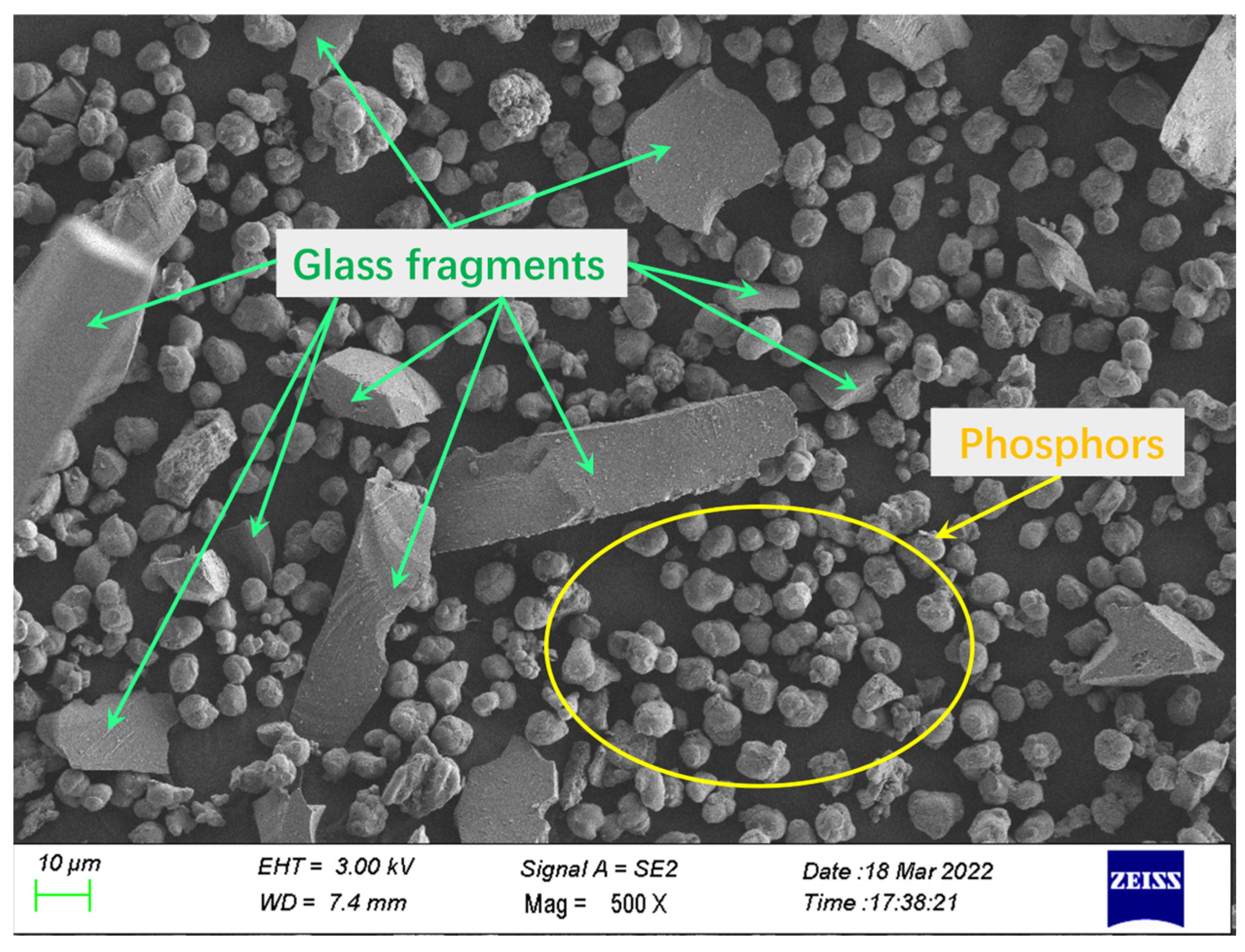
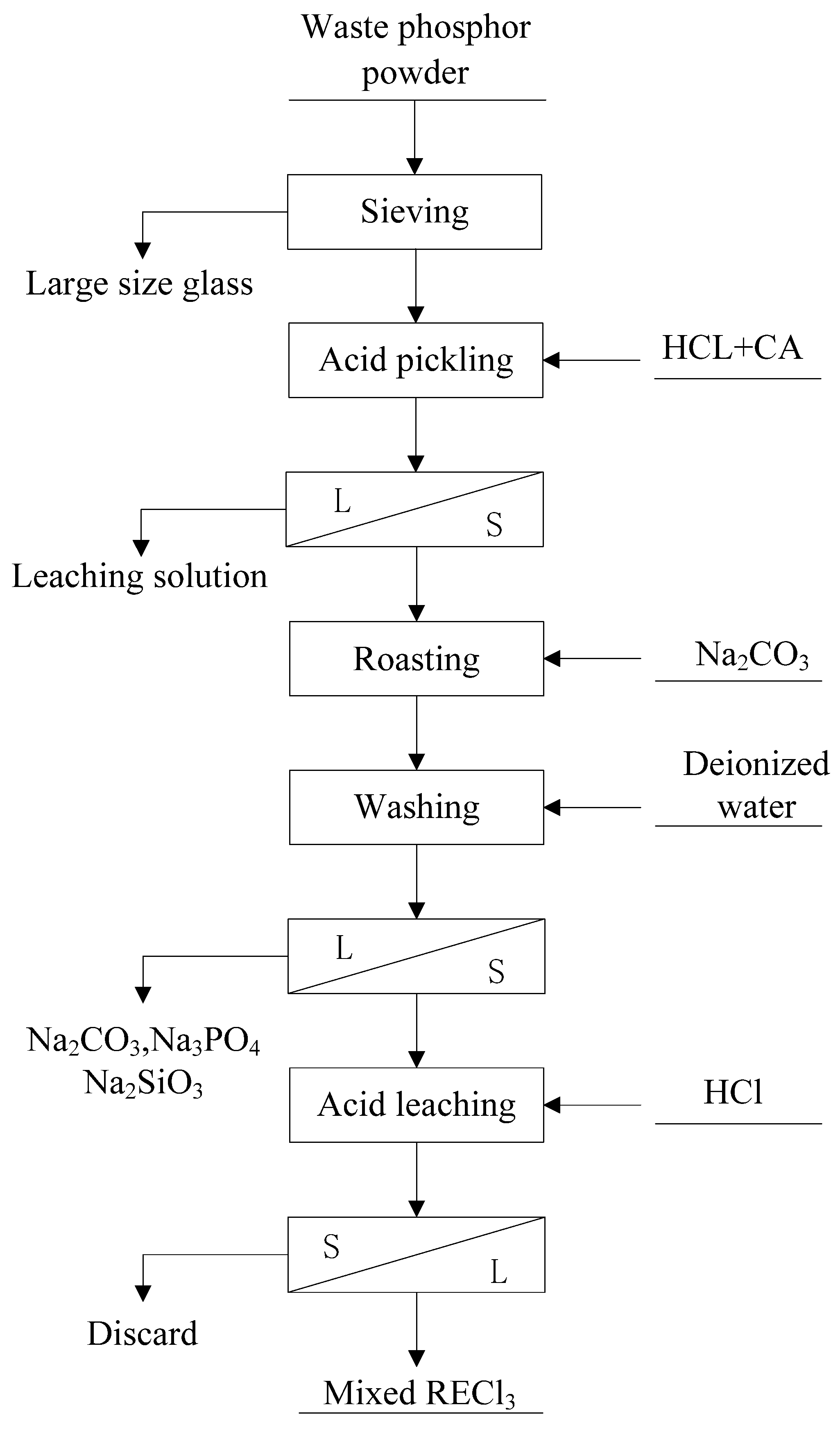


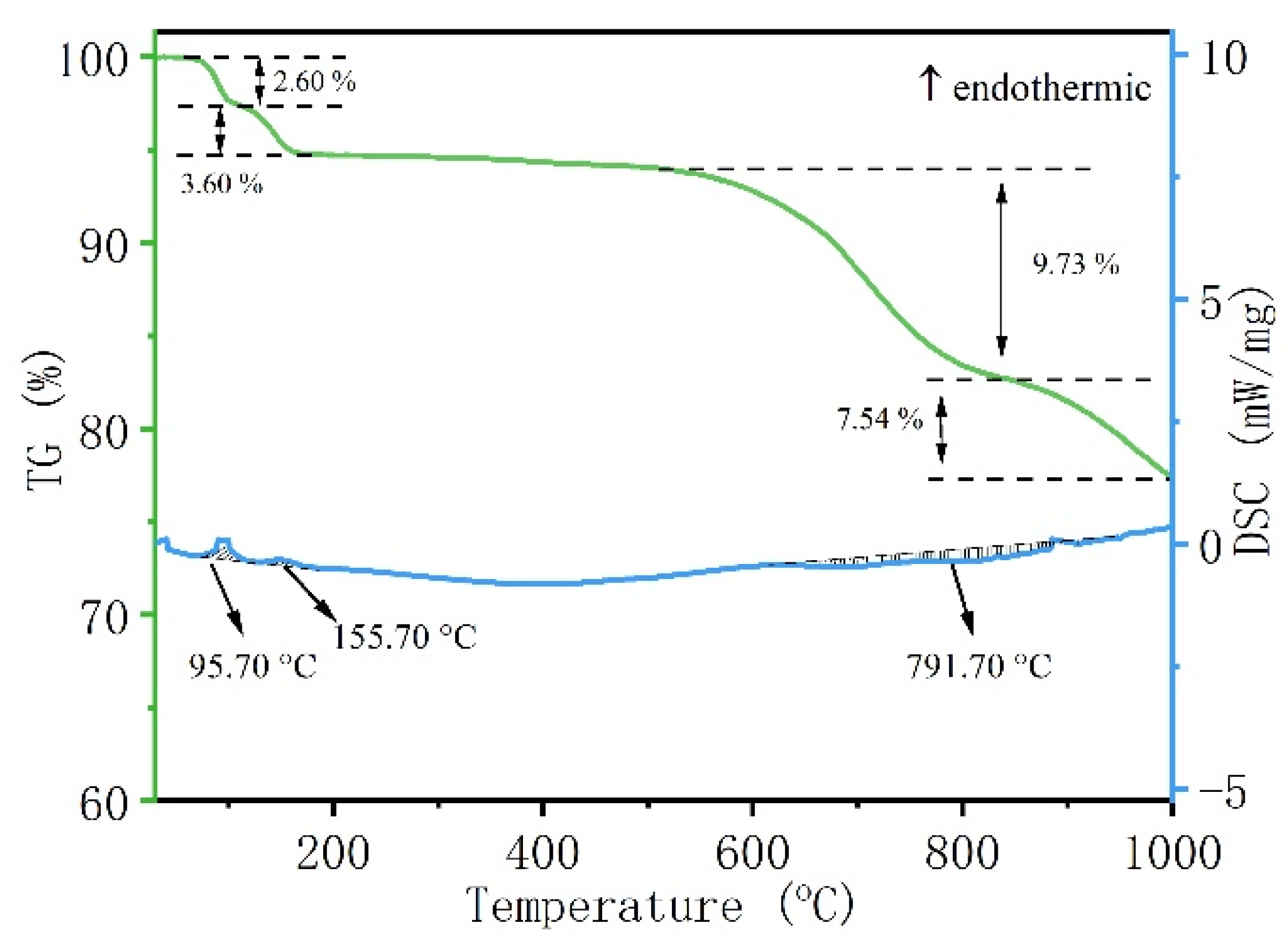
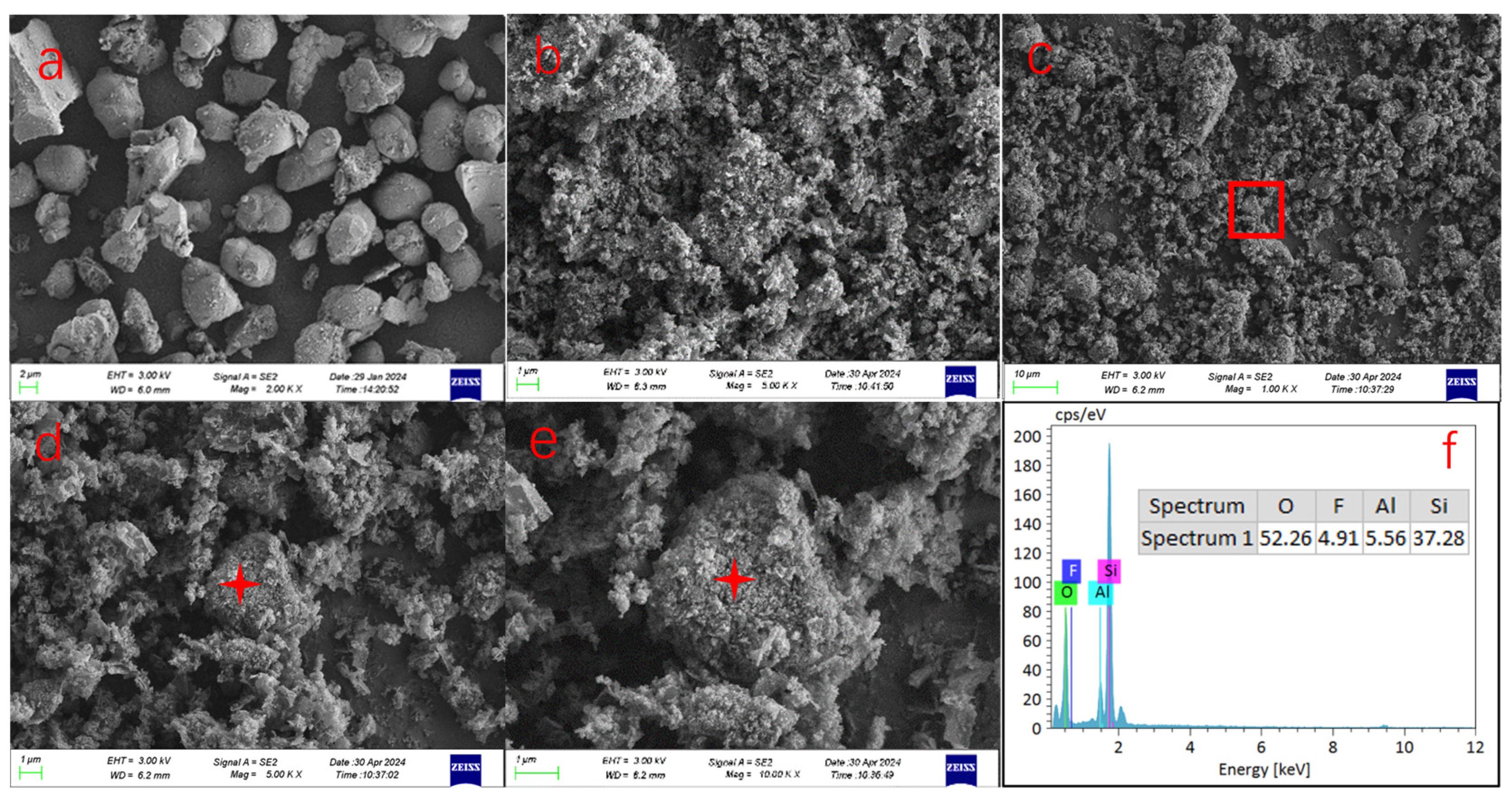
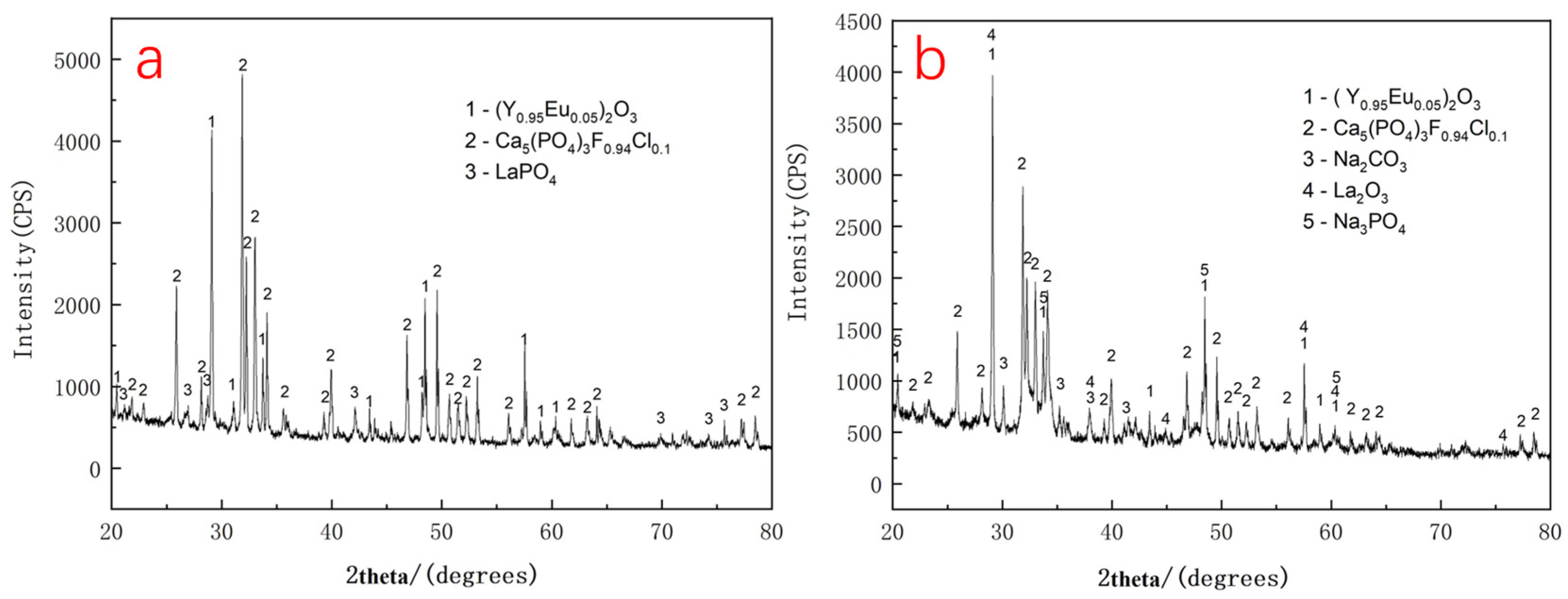
| Component | REO | Ca | P | Si | Na | Ba | Mn | Sr | F | Cl |
|---|---|---|---|---|---|---|---|---|---|---|
| Content | 9.3 | 28.3 | 11.6 | 5.7 | 1.8 | 1.2 | 0.4 | 0.6 | 2.2 | 0.4 |
| REO | Y2O3 | La2O3 | CeO2 | Eu2O3 | Tb4O7 |
|---|---|---|---|---|---|
| Content | 66.7 | 15.0 | 9.7 | 4.5 | 4.1 |
| Component | REO | Ca | P |
|---|---|---|---|
| Before pickling | 10.9 | 24.8 | 11.9 |
| After pickling | 17.0 | 13.0 | 6.4 |
Disclaimer/Publisher’s Note: The statements, opinions and data contained in all publications are solely those of the individual author(s) and contributor(s) and not of MDPI and/or the editor(s). MDPI and/or the editor(s) disclaim responsibility for any injury to people or property resulting from any ideas, methods, instructions or products referred to in the content. |
© 2025 by the authors. Licensee MDPI, Basel, Switzerland. This article is an open access article distributed under the terms and conditions of the Creative Commons Attribution (CC BY) license (https://creativecommons.org/licenses/by/4.0/).
Share and Cite
Qin, Y.; Hou, S.; Liu, C.; Borjigin, B.; Zhang, X.; Guo, C.; Zhang, B. Recovery of Rare Earth Elements from Waste Phosphate-Based Phosphors Containing Glass by Pre-Enrichment—Alkali Roasting Method. Separations 2025, 12, 293. https://doi.org/10.3390/separations12110293
Qin Y, Hou S, Liu C, Borjigin B, Zhang X, Guo C, Zhang B. Recovery of Rare Earth Elements from Waste Phosphate-Based Phosphors Containing Glass by Pre-Enrichment—Alkali Roasting Method. Separations. 2025; 12(11):293. https://doi.org/10.3390/separations12110293
Chicago/Turabian StyleQin, Yufang, Shaochun Hou, Chenghong Liu, Burenbayaer Borjigin, Xuejie Zhang, Chunlei Guo, and Bo Zhang. 2025. "Recovery of Rare Earth Elements from Waste Phosphate-Based Phosphors Containing Glass by Pre-Enrichment—Alkali Roasting Method" Separations 12, no. 11: 293. https://doi.org/10.3390/separations12110293
APA StyleQin, Y., Hou, S., Liu, C., Borjigin, B., Zhang, X., Guo, C., & Zhang, B. (2025). Recovery of Rare Earth Elements from Waste Phosphate-Based Phosphors Containing Glass by Pre-Enrichment—Alkali Roasting Method. Separations, 12(11), 293. https://doi.org/10.3390/separations12110293





